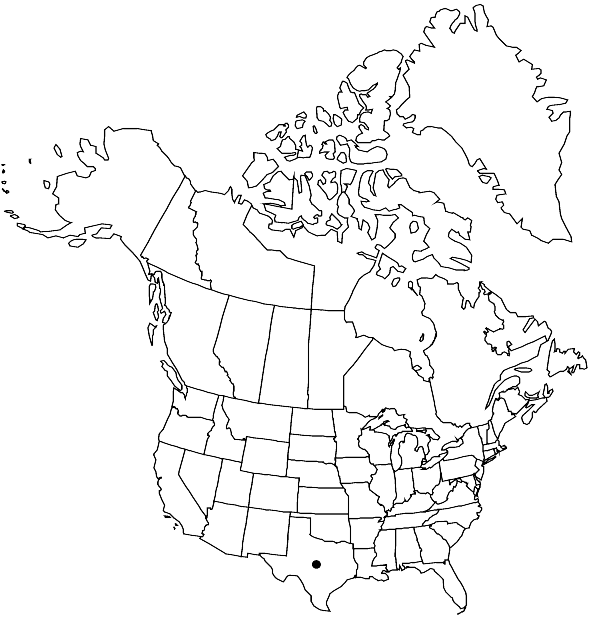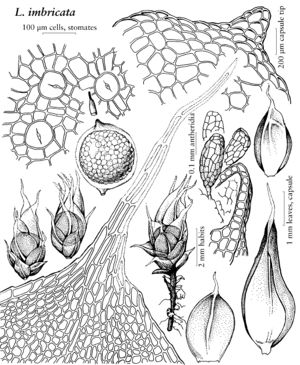Difference between revisions of "Lorentziella imbricata"
in H. G. A. Engler and K. Prantl, Nat. Pflanzenfam. 216[I,3]: 511. 1903,.
FNA>Volume Importer |
FNA>Volume Importer |
||
| Line 13: | Line 13: | ||
|name=Acaulon runyonii | |name=Acaulon runyonii | ||
|authority=Grout | |authority=Grout | ||
| − | }}{{Treatment/ID/Synonym | + | }} {{Treatment/ID/Synonym |
|name=Acaulon megalosporum | |name=Acaulon megalosporum | ||
|authority=Grout | |authority=Grout | ||
| Line 31: | Line 31: | ||
|elevation=low to moderate elevations | |elevation=low to moderate elevations | ||
|distribution=Tex.;South America (Argentina;Paraguay;Uruguay). | |distribution=Tex.;South America (Argentina;Paraguay;Uruguay). | ||
| − | |discussion=<p>Lorentziella imbricata is known from Bastrop, Brazos, Burnet, Cameron, Gillespie, Llano, and Travis counties in central Texas. It is named for the closely imbricate distal leaves. In Texas, fertilization and sporophyte growth occur in the winter months and by late spring little trace of the above-ground plants remain. Spores have been described as angular, probably due to packing and space constraints within the capsule. Stomata have been described as having a single guard cell with a central opening or two guard cells. Careful study of guard cells reveals that most are single-celled, 2-nucleate with a central opening.</p> | + | |discussion=<p><i>Lorentziella imbricata</i> is known from Bastrop, Brazos, Burnet, Cameron, Gillespie, Llano, and Travis counties in central Texas. It is named for the closely imbricate distal leaves. In Texas, fertilization and sporophyte growth occur in the winter months and by late spring little trace of the above-ground plants remain. Spores have been described as angular, probably due to packing and space constraints within the capsule. Stomata have been described as having a single guard cell with a central opening or two guard cells. Careful study of guard cells reveals that most are single-celled, 2-nucleate with a central opening.</p> |
|tables= | |tables= | ||
|references= | |references= | ||
| Line 55: | Line 55: | ||
|publication year= | |publication year= | ||
|special status= | |special status= | ||
| − | |source xml=https://jpend@bitbucket.org/aafc-mbb/fna-data-curation.git/src/ | + | |source xml=https://jpend@bitbucket.org/aafc-mbb/fna-data-curation.git/src/8f726806613d60c220dc4493de13607dd3150896/coarse_grained_fna_xml/V27/V27_277.xml |
|genus=Lorentziella | |genus=Lorentziella | ||
|species=Lorentziella imbricata | |species=Lorentziella imbricata | ||
Revision as of 16:53, 18 September 2019
Plants small, bulbiform in shape with distally densely crowded leaves, light green to glaucous, in dense clusters or tufts. Stems above ground erect, 2–5 mm. Leaves 1.5–4 mm; proximal leaves less crowded, ovate with acute tips; margins entire to weakly serrate; distal laminal cells elongate, oblong-hexagonal to short-rhomboidal; proximal laminal cells quadrate to short-rectangular. Sexual condition paroecious with antheridia in naked clusters in axils of distal leaves. Seta short, less than 0.25 mm. Capsule immersed to slightly emergent when mature and fully expanded, pale green, cleistocarpous, globose to ellipsoidal or ovate with a truncate base, 1–1.5 mm long, 1–2 mm in diameter; stomata at base of capsule with a central opening in an imperfectly divided single, 2-nucleate guard cell. Calyptra narrowly conic, covering tip of capsule. Spores of 2 sizes: large, faintly granulose, yellow-brown, 120–160 µm, and small, densely granular, shriveled, 32–73 µm.
Phenology: Capsules mature winter.
Habitat: Often found in loose soil at granitic outcrop margins in association with Selaginella
Elevation: low to moderate elevations
Distribution

Tex., South America (Argentina, Paraguay, Uruguay).
Discussion
Lorentziella imbricata is known from Bastrop, Brazos, Burnet, Cameron, Gillespie, Llano, and Travis counties in central Texas. It is named for the closely imbricate distal leaves. In Texas, fertilization and sporophyte growth occur in the winter months and by late spring little trace of the above-ground plants remain. Spores have been described as angular, probably due to packing and space constraints within the capsule. Stomata have been described as having a single guard cell with a central opening or two guard cells. Careful study of guard cells reveals that most are single-celled, 2-nucleate with a central opening.
Selected References
None.
